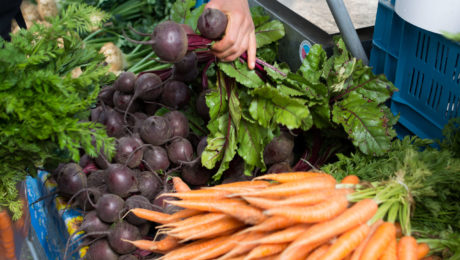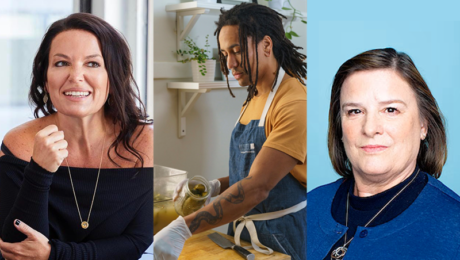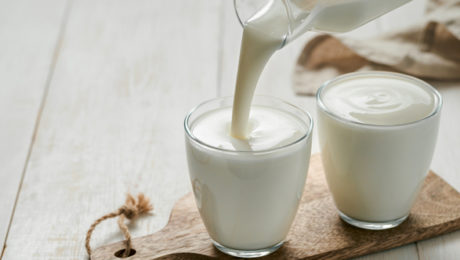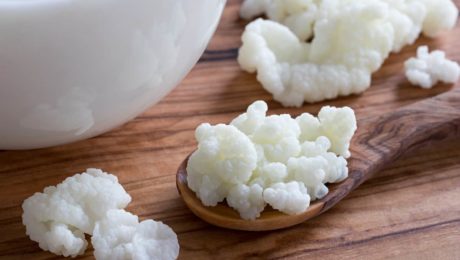Is Water Kefir Drink of 2023?
Water kefir or tibicos is making a splash. Food trend analysts are highlighting tibicos as the “it” drink of the new year.
Tibicos is ripe for popularity in 2023. More consumers are shunning soda in favor of functional drinks. Tibicos is not sugar-filled like soda, not as tart at kombucha and more flavor-filled than seltzer water.
An article on Yahoo notes that water kefir has a unique taste compared to other fermented drinks like kombucha or kvass. “Tibicos is knows as a ‘softer’ fermented beverage because of its lactic acid,” the article reads.
The growing trend is worth highlighting, but TFA notes the Yahoo article got a few facts wrong — like the spelled of kvass and chicha (a fermented soda). Also, though the article states the microbiota of tibicos contains different acids, yeast is not one of them. Yeast will never produce acid.
Read more (Yahoo)
- Published in Food & Flavor
“Dairy is Ripe for Innovation”
As the dairy industry continues to suffer from low sales, could fermentation help the industry meet changing consumer needs? Functional dairy products (like fermented dairy) and animal-free precision fermentation products are major consumer trends for the dairy industry to adapt.
Functional dairy products are “ripe for expansion,” said Brad Schwan, vice president of Archer-Daniels-Midland Company, said brands have to invest in alt protein technologies to feed the future tech-savvy generation. Fermented dairy – like yogurt, kefir and fresh cheese – are all functional dairy.Fifty-eight percent of global consumers perceive a connection between gut function and other aspects of well-being. Consumers are looking for dairy with simple ingredient lists.
“The gut microbiome is a key growth area for functional, tailored offerings, as more consumers are making the link between their gut, digestive health and overall well-being,” Schwan added.
Consumers are looking for dairy with simple ingredient lists. They want their dairy to support pre- and post-workout goals, energy solutions, hydration, digestive support and immune function.
More consumers are embracing a mix of an animal- and plant-based diet. Fifty-two percent of consumers eat a flexitarian diet now.
Alt protein – once seen as a fringe biotechnology – is becoming more mainstream. Brad Schwan, vice president of Archer-Daniels-Midland Company, said brands have to invest in alt protein technologies to feed the future tech-savvy generation.
“While consumer acceptance of alternative solutions beyond plant proteins is still building, we foresee digital-natives Gen Z and Gen Alpha leading the way in the growing acceptance of novel methods and technologies,” he said in a report on global food trends. “Additionally, the dairy industry is ripe for more innovation in the coming year, through leveraging both new technologies…As consumers grow more accustomed to seeing novel proteins from unexpected places, the alternative dairy arena will flourish with new possibilities.”
Read more (Dairy Reporter)
- Published in Business
Does Organic vs. Conventional Matter for Fermented Foods?
Organic food is considered by some to be healthier and more nutritious than its conventional counterpart. But what about when that food is fermented? Does organic vs. conventional matter?
A new study reveals some surprising results: when it comes to fermented foods, “the quality of organic food is not always better than conventional food.”
Organic vs. conventional agricultural production is a hotly debated topic – some reports indicate organic food is more nutritious, but other research suggests the nutritional differences are not significant. Meanwhile, fermented foods are scientifically-proven to include higher nutritional value. “During fermentation, the concentration of many bioactive compounds increases, and the bioavailability of iron, vitamin C, beta carotene, or betaine is also improved,” the study notes. Fermented products also “inhibit the development of pathogens in the digestive tract.”
Researchers at the Bydgoszcz University of Science and Technology in Poland questioned whether fermenting organic food would change its nutritional output versus using conventional food. Their results were published in the journal Molecules.
Analyzing fermented plants (pickles, sauerkraut, beet and carrot juices) and dairy (yogurt, kefir and buttermilk), researchers measured the vitamins, minerals and lactic acid bacteria in the items. They compared using organic ingredients in one group to products made from conventional ingredients.
“Research results do not clearly indicate which production system–conventional or organic–provides higher levels of bioactive substances in fermented food,” the study reads.
Results were mixed. Lactic acid bacteria – the good, healthy kind – were higher in organic sauerkraut, carrot juice, yogurt and kefir. Organic kraut and pickles produced more vitamin C than conventional versions. And calcium levels were higher in yogurt made with organic milk.
But, interestingly, lactic acid bacteria levels were higher in conventional pickles and beet juice. Conventional beet juice also had five times more beta-carotene (vitamin A).
Read more (Molecules)
Chicago: A Fermentation Hub
If you still think of hot dogs and deep dish pizza as the icons of Chicago’s culinary scene, you need to think again. The so-called Capital of the Midwest is a hub of innovation in the food industry. Chicago has the largest food and beverage production in the U.S., with an annual output of $9.4 billion. Food startup companies in the region raised $723 million in venture capital last year.
“Chicago is one of the most diverse cities for eating,” says Anna Desai, Chicago-based influencer of Would You Like Something to Eat on Instagram. ”Our culinary scene is constantly elevating and evolving. We are always just a neighborhood or tollway away from experiencing a new culture and cuisine. I’m most excited when I find an under-the-radar spot or discover a maker who can pair flavors and ingredients that get you curious and wanting more.”
Desai started her blog in part because she wanted to champion the Asian American and Pacific Islanders (AAPI) community in the Chicago food and beverage scene. “Food has long served as a cultural crossroad,” she adds, and Chicago’s multicultural cuisine exemplifies that sentiment.
Chicago is home to some of the most creative minds in fermentation, from celebrity chefs, zero waste ventures, alternative protein corporations and the world’s largest commercial kefir producer. There are dozens of regional and artisanal producers lacto-fermenting vegetables, brewing kombucha and experimenting with microbes in food and drink.
“Chicago is a great food city in its own right, so naturally there is a ton of talent in the fermentation space,” says Sam Smithson, chef and culinary director of CultureBox, a Chicago-based fermentation subscription box. “The pandemic’s effect on restaurants has also spawned a new wave of fermenters (ourselves included) that are looking for a path outside the grueling and uncertain restaurant structure to display our creative efforts. This new wave is undoubtedly community-motivated and concerned more with mutual aid than competition. There is a general feeling that we are all working towards the same goal so cooperation and collaboration is soaring and we are seeing incredible food come from that.”
Flavor is King
Flavor development is still the prime motivation for chefs to experiment with fermentation. A good example is at Heritage Restaurant and Caviar Bar in Chicago’s Humboldt Park neighborhood.
“Fermentation has been a cornerstone of the restaurant since its inception,” says Tiffany Meikle, co-owner of Heritage with her husband, Guy. “With the diverse cuisines we pull from, both from Eastern and Central Europe and East Asia, we researched fermentation methodologies and histories, and started to ‘connect the dots’ of each culture’s fermentation and pickling backgrounds.”
Menus have included sourdough dark Russian rye bread, toasted caraway sauerkraut, kimchi made from apples, Korean pears and beets and a kimchi using pickled ramps (wild onions). Heritage has also expanded their fermentation program to the bar, where they’ve created homemade kombucha, roasted pineapple tepache, sweet pickled fruits for cocktail garnishes, and kimchi-infused bloody mary mix.
“It’s fascinating to me that there are so many ingredients you can use in a fermented product,” says Claire Ridge, co-founder of Luna Bay Booch, a Chicago-based alcoholic kombucha producer. “People are really experimenting with interesting ingredients in kombucha…I have seen brewers do some of the wildest recipes and some recipes that are very basic.”
Innovating Food
Chicago-based Lifeway Kefir is indicative of the innovation taking place in the city. Last year the company expanded into a new space: oat-based fermentation, launching a dairy-free, cultured oat milk with live and active probiotics.
“We’ve spent so many years laying the groundwork in fermented dairy,” says Julie Smolyansky, CEO. “Now we’re experimenting and expanding to see what’s over the next horizon, though we’ll always have kefir as our first love.”
Chicago is home for two inventive fermented alternative protein startups: Nature’s Fynd and Hyfé Foods. Both companies were born out of the desire to create alt foods without damaging the environmental.
“Conscious consumerism is a trend that’s driving many people to try alternative proteins, and it’s not hard to understand why,” says Debbie Yaver, chief scientific officer at Nature’s Fynd. The company uses fermentation technology to grow Fy, a nutritional fungi protein. “Fungi as a source of protein offer a shortcut through the food chain because they don’t require the acres of land or water needed to support plant growth or animal grazing, making fungi-based protein more efficient to produce than other options.”
Alternative foods outlasting the typical trend cycle is a challenge for companies like Nature’s Fynd. When grown at scale, Fy uses 99% less land, 99% less water and emits 94% fewer greenhouse gasses than raising beef. But, to make an impact, “we need more than just vegans and vegetarians to make changes in their diets,” Yaver adds.
Waste Not
Numerous companies are using fermentation as a means to eliminate waste. Hyfé Foods, another player in the alternative protein space, repurposes sugar water from food production to create a low-carb, protein-rich flour. Fermentation turns a waste product into mycelium flour, mycelium being the root network – or hyphae (hence the company name) — of mushrooms.
“[We’re] diverting input to the landfill and reducing greenhouse gas emissions at scale,” says Michelle Ruiz, founder. “Hyfé operates at the intersection of climate and health, enabling regional production of low cost, alternative protein that reduces carbon emissions and is decoupled from agriculture.”
Symmetry Wood is another Chicago upcycler. They convert SCOBY from kombucha into a material, Pyrus, that resembles exotic wood. Founder Gabe Tavas says Pyrus has been used to produce guitar picks, jewelry and veneers. Symmetry uses the discarded SCOBY from local kombucha brand Kombuchade.
Many area restaurants and culinary brands also use fermentation to preserve food for the long Chicago winters, when local produce isn’t available. Pop-up restaurant Andare, for example, incorporates fermentation into classic Italian dishes.
“Finding ways to utilize what would otherwise be waste products inspired our initial dive into fermentation. The goal is not just to use what’s leftover, but to make it into something delicious and unique,” says Mo Scariano, Andare’s CEO. “One of our first dishes employing koji fermentation was a summer squash stuffed cappellacci served with a butter sauce made from carrot juice fermented with arborio rice koji. Living in a place with a short grow season, preservation through fermentation allowed us access throughout the year to ingredients we only have fresh for a few weeks during the summer.”
Industry Challenges
Despite growing interest and increasing sales, fermenters face some significant hurdles.
Smithson at CultureBox says he sees that consumers are open to unorthodox, less traditional ferments. Though favorites like kombucha and sauerkraut dominate the market, “their share is being encroached on by increasingly more varied and niche ferments.” But getting these products to market can be a challenge. Small-scale, culinary producers are challenged by the regulatory hoops they need to jump through to legally sell ferments – especially unusual ones a food inspector doesn’t recognize.
“The added layer of city regulations on top of state requirements, sluggish health department responses, and inflexible policy chill the potential of small producers,” Smithson says. But he highlights the recently-passed Home-to-Market Act of Illinois as positive legislation helping startup fermenters.
Consumer awareness and education are also vital. “Many longstanding and harmful misconceptions on the safety and value of fermented products still exist,” Smithson says.
Matt Lancor, founder and CEO of Kombuchade makes consumer education a core part of marketing, to align kombucha as a recovery drink.
“Most mainstream kombuchas are marketed towards the yoga/crystal/candle crowd, and I saw a major opportunity to create and market a product for the mainstream athletic community,” he says. “We’re on a mission to educate athletes and the general public about these newly discovered organs [the gut] – our second brain – and fuel the next generation of American athletes with thirst quenching, probiotic rich beverages.”
Product packaging provides much of a consumer’s education. Jack Joseph, founder and CEO of Komunity Kombucha, says simplicity is key.
“People are more conscious of their health now, more than ever before,” he says. “So now it comes down to the education of the product and creating something that is transparent and easy for the consumer to digest.”
Sebastian Vargo of Chicago-based Vargo Brother Ferments agrees.
“Oftentimes food is considered ‘safe’ due to lack of microbes and how sterile it is,” he says. “Fermentation eschews the traditional sense of what makes food ‘safe’. We need to create a set standardized guide for fermented food to follow, and change our view of living foods in general. One of the brightest spots to me is the fact that fermentation is really hitting its stride and finding its place in the modern world, and I don’t see it going anywhere but up in the near future.”
- Published in Business, Food & Flavor
Bubbling Over: Chicago Fermentation Scene
In anticipation for our conference FERMENTATION 2022 in Chicago, TFA asked over a dozen area fermenters about what they love about the city’s fermentation scene. Their answers touched on a number of points: creativity in foods and beverages, diverse offerings, scrappy and determined founders, supportive community and evolving foodscape.
Below are the answers from three local fermentation experts – kefir company founder Julie Smolyansky (Lifeway Kefir), local ferments producer Sebastian Vargo (Vargo Brother Ferments) and chief scientific officer Debbie Yaver, PhD (Nature’s Fynd).
The question: What do you love about the Chicago fermentation scene?
Julie Smolyansky, Lifeway Kefir
Chicago is a true melting pot. We have diversity, talent, and lots of skilled manufacturing talent. It’s one of the premier food cities in the world and I’m so grateful that we’ve been able to build our business and community in Chicago. The natural foods, fermentation, and dining scene all commingle to create opportunities for a special type of risk-taking that’s uniquely Chicago. Lots of it bubbles under the radar – who would have guessed that the kefir capital of the United States is in the Midwest?
Sebastian Vargo, Vargo Brother Ferments
I love the fact that we are seeing more fermentation than ever, from restaurants to store shelves to folks starting projects at home. I love the community behind it, folks are sharing recipes and exchanging tips and tricks. People don’t have time for gatekeeping anymore.
Debbie Yaver, Nature’s Fynd
I love that it flips the script. For so long Chicago was known as the “Hog Butcher to the World,” but now one of the oldest technologies in the books is experiencing a renaissance. There are lots of companies utilizing traditional fermentation, but not as many in the food space. It’s exciting to be one of the newer kids on the block, to see how different companies are putting fermentation to work, and to get to pull from such a stocked talent pool. Chicago is full of bright minds with deep fermentation experience.
- Published in Food & Flavor
A Nutrition Pro’s Fermentation Guide
Nutrition professionals need to share the details when recommending fermented products to clients. What are the health benefits of the specific food or beverage ? Does the product contain probiotics? Live microbes?
“There are a vast array of fermented foods. This is important because it means there can be tasty, culturally appropriate options for everyone,” says Hannah Holscher, PhD and registered dietitian (RD). But, she adds, remember that these are complex products.
Holscher spoke at a webinar produced by the International Scientific Association for Probiotics and Prebiotics (ISAPP) and Today’s Dietitian. Joined by Jennifer Burton, RD and licensed dietitian/nutritionist (LDN), the two addressed the topic Fermented Foods and Health — Does Today’s Science Support Yesterday’s Tradition? Hosted by Mary Ellen Sanders, executive director of ISAPP, the presentation touched on the foundational elements of fermented foods, their differences from probiotics, the role of microbes in fermentation, current scientific evidence supporting health claims and how to help clients incorporate fermented foods in their diets.
Sanders called fermented foods “one of today’s hottest food categories.” Today’s Dietitian surveys show they are a top interest to dietitians, as the general public often turns to them with questions about fermented foods and digestive health.
Here are three factors highlighted in the webinar that dietitians should consider before recommending fermented foods and beverages.
Does It Contain Live Microbes?
Fermentation is a metabolic process – microorganisms convert food components into other substances.
In the past decade, scientists have applied genomic sequencing to the microbial communities in fermented foods. They’ve found there’s not just one microbe involved in fermentation, Holscher explained, there may be many. The most common microbes in fermented foods are streptococcus, lactobacillaceae, lactococcus and saccharomyces.
But deciphering which fermented food or beverages contains live microbes can be difficult.
Live microorganisms are present in foods like yogurt, miso, fermented vegetables and many kombuchas. But they are absent in foods that were fermented then heat-treated through baking and pasteurization (like bread, soy sauce, most vinegars and some kombucha). They’re also absent in fermented products that are filtered (most wine and beers) or roasted (coffee and cacao). And there are foods that are mistakenly considered fermented but are not, like chemically-leavened bread, vegetables pickled in vinegar and non-fermented cured meats and fish.
“The main take-home message is that it’s not always easy to tell if a food is a fermented food or not. So you may need to do more digging, either by reading the label more carefully or potentially contacting the food manufacturer,” Holscher said. “When we just think of if live microbes are present or not, a good rule of thumb is if that food is on the shelf at your grocery store, it’s very likely that it does not contain live microbes.”
Does It Contain Probiotics?
The dietitians stressed: probiotics are not the same as fermented foods.
“Probiotics are researched as to the strains and the dosages to be able to connect consumption of a probiotic to a health outcome,” Holscher said. “These strains are taxonomically defined, they’ve been sequenced, we know what these microorganisms can do. They also have to be provided in doses of adequate amounts of the live microbes so foods and supplements are sources of probiotics.”
Though fermented foods can be a source of probiotics, Holscher notes: “In most fermented foods, we don’t know the strain level designation.”
“For most of the microbes in fermented foods, we’ve just really been doing the genomic sequencing of those over the last 10 years and so we may only know them to the genus level right,” she said. For example, we know lactic acid bacteria are present in kimchi and sauerkraut.
Holscher suggests, if a client has a specific health need, a probiotic strain should be recommended based on its evidence-based benefits. For example, the probiotic strain saccharomyces boulardii is known to help prevent travel-related diarrhea, and so would be good for a patient to take before a trip.
“If you’re looking to support health and just in general, fermented foods are a great way to go,” Holscher says.
The speakers recommended looking for probiotic foods in the Functional Food Section of the U.S. Probiotic Guide.
Does Research Support Health Claims?
Fermentation contributes to the functional and nutritional characteristics of foods and beverages. Fermented foods can: inhibit pathogens and food spoilage microbes, improve digestibility, increase vitamins and bioactives in food, remove or reduce toxic substances or anti-nutrients in food and have health benefits.
But research into fermented foods has been minimal, mostly limited to fermented dairy. Dietitians should be careful making strong recommendations based on health claims unless those claims are supported by research. And food labels should always be scrutinized.
“There’s a lot of voices out there that are trying to answer this question [Are fermented foods good for us?],” says Burton. “Many food manufacturers have published health claims on their labels talking about these benefits and, while those claims are regulated, they’re not always enforced. Just because it has a food health claim on it, that claim may not be evidence-based. There’s a lot of anecdotal accounts of benefits coming from eating fermented foods and the research is suggesting some exciting potential mechanisms. But overall we know as dietitians we have an ethical responsibility to practice on the basis of sound evidence and to not make strong recommendations if those are not yet supported by research.”
Reputable health claims are documented in randomized control trials. But only “possible benefits” can be linked to nonrandomized controlled trials. And non-controlled trials are the least conclusive studies of all.
For example, Burton puts miso in the “possible benefits” category because, with its high sodium content, there’s not enough research indicating it’s safe for patients with heart disease. Similarly, she does not recommend kombucha because of its extremely limited clinical research and evidence.
“We have to use caution in making these recommendations,” Burton says.
This is why Burton advises dietitians to be as specific as possible. Don’t just tell patients “eat fermented foods” — list the type of fermented food and its brand name. She also says to give patients the “why” — what is the benefit of this fermented food? Does it increase fiber or boost bioavailability of nutrients?
“Are fermented foods good for us? It’s safe to say yes,” Burton says. “There’s a lot that we don’t know, but the body of evidence suggests that fermentation can improve the beneficial properties of a food.”
Fermented Dairy Improves Memory
A new study found fermented dairy products reduce memory loss. The study, published in Nutritional Neurosciences, confirms there is a connection between the gut microbiome and the nervous system, known as the gut-brain axis
The adults in the test regularly consumed a dairy-based fermented drink, containing 25-30 billion colony forming units (CFUs). Drinking fermented dairy — like yogurt, kefir or fermented whey — “increased the presence of certain microorganisms in the gut and improved relational memory in healthy adults.”
Read more (Nutritional Neurosciences)
Analyzing the World’s Fermented Beverages
Can indigenous fermented beverages play a prominent role in a healthy diet? Biochemists studied four commercial products – kefir and ryazhenka from Russia, amasi and mahewu from South Africa. Their research was published in the journal Foods.
Researchers from the Institute of the Research Center of Biotechnology of the Russian Academy of Science (RAS) and South Africa’s Durban University of Technology discovered key elements of the fermented drinks. The three that are milk-based had more antioxidants than the corn-based one, while the corn drink (mahewu) was “better at suppressing the angiotensin-converting enzyme.” Kefir and ryazhenka, meanwhile, have a more diverse composition of fatty acids.
“Usually, food is considered only as a source for sustenance. However, more and more people (are starting) to believe that it also should preserve and improve health,” Konstantin Moiseenko, co-author of the study and a research fellow at RAS in Moscow. He notes modern science allows “mankind to look differently at the usefulness of traditional, centuries-old foods. Our research focuses on fermented products, which regular consumption can potentially prevent atherosclerosis, hypertension and thrombosis.”
Read more (Lab Manager and Foods)
Evidence of Fermented Health Benefits
We’re on the cusp of a new generation of health-promoting foods, foods that will harness the power of microbes present in fermented foods and beverages.
Paul Cotter, head of Food Bioscience Department at Teagasc Food Research Centre in Ireland, envisions a future system where fermented foods are made with strains having scientifically-proven health-promoting benefits. His lab is integrating microbiome and metabolic data and using DNA sequencing to drill down to specific health benefits.
“We’ve really only scratched the surface as to the real potential of all those different microbes and what they could be doing,” says Cotter, who is also the principal investigator with the APC Microbiome Ireland. “Whether a particular food is health promoting or not will be dictated by what microbe is in there and can only be proved by carrying out the appropriate studies.”
Cotter was a speaker at TFA’s conference FERMENTATION 2021. He made a case for establishing minimum standards for fermented foods and beverages. In his scenario, kombucha or kefir couldn’t be labeled as such without using a scientifically-backed combination of microbial strains.
“That ensures that the kind of pseudo fermented foods — the foods that are fermented but not really with the right microbes — don’t get on the market or can’t be distinguished,” Cotter says.
Not all Fermented Foods are Equal
There is scientific evidence of the health benefits of frequently and regularly consuming fermented foods and beverages. They can prevent illness, provide a source of live and active microbes, improve the digestibility of foods, increase certain vitamins and bioactive compounds and remove or reduce toxic compounds like lactose.
“Ultimately, I’m a scientist and so I want to see proof that underpins the claims associated with a particular food,” Cotter says. “While there’s a lot of good information out there, I think also some of the claims are doing a disservice to the fermented food industry and to those who make fermented foods in their homes because they’re overstating the potential health benefits.”
Problematic, too, are fermented foods made with shortcuts and additives. Cotter’s lab is currently studying kefir, and they found that not all are equal. Traditional kefir has been documented as helping to reduce weight and improve cholesterol and liver triglyceride levels. But some brands of commercial kefir they studied didn’t produce those same health benefits. And they found that some of the kefir on the market was nothing more than watered-down yogurt.
“Consumer beware: the benefits weren’t the same for each kefir and differ depending on what the microbes present in the kefir were,” says Cotter, a self-described fermented foods nerd. ”I think that’s a problem for lots of other fermented foods too, and I really feel for consumers who don’t have a microbiological background and are reading a label and assuming that they are consuming a fermented beverage or fermented food that has lots of beneficial microbes in there and is made in the artisanal way that that food has been made over hundreds of different years.”
What are the health benefits?
Cotter’s lab has used in-depth analyses to detail the microbial composition of a food, including naming the microorganisms present and their capabilities. They’ve identified “completely novel species that had never been found previously,” Cotter says. An example is African fermented food, which contains a huge diversity of microbes, including ones not typically found in fermented foods in the West.
The highest level of what’s called “Health Associated Gene Clusters” are in fermented foods, specifically those brine- (like sauerkraut and kimchi) or sugar-based (kefir and kombucha). Cotter notes the genes in fermented foods are health promoting because the microbes are closely related to probiotics.
“What we can do is to try to harness the microbes that are present and use them in a way that facilitates large-scale production,” Cotter says.
Covid & the 4k’s: 4 Foods “Many People Don’t Know About”
Renowned professor, epidemiologist and author of The Diet Myth and Spoon Fed Tim Spector is encouraging people to eat the 4k’s: kefir, kombucha, kimchi and kraut. His studies found diet plays a role in preventing severe symptoms of Covid.
Spector is a leading expert on long Covid, the symptoms that can continue for extended periods after an initial infection. He leads the ZOE Covid Study, created by scientists and doctors at King’s College London (where he is based), Stanford, Harvard, Massachusetts General Hospital and health science company ZOE. Last year Spector helped research the attributes and predictors of long Covid, the results of which were published in the journal Nature Medicine.
A microbiome researcher, Spector advocates for people to eat a diverse diet to improve the trillions of microbes in the gut.
“We know from Covid now that your gut health is crucial for your immune system,” he told ITV. “If we can focus on our gut health…gut microbiome is really crucial.”
Diet must be high-quality to improve immunity, he stresses. In the ZOE Covid study, researchers have found eating “the right things and avoiding feeding (the gut) the bad things, that’s what made the difference to getting long Covid,” he said. Fermented foods have proven health benefits, but Spector says many people opt for cheaply-made yogurts and cheeses prevalent in the grocery store to get their daily dose of fermented foods. This dairy is full of sugar and artificial ingredients, which thwart the positive effects of fermentation.
“The other fermented foods that many people don’t know about are what I call the 4 k’s,” Spector says: kefir, kombucha, kimchi and kraut (sauerkraut). He encourages “small shots a day” of a fermented food or beverage. “That really is a powerful enhancer of your microbes. And all these things are going to be cheaper actually than taking multivitamins every day of your life.”
Spector is not a fan of supplements, like pill forms of vitamins and nutrients. Many are proven not to work, he explained. In his studies on the effects of supplements on long Covid, there were minimal benefits for women and none for men.
“People are much better off getting all their vitamins and nutrients by having a diverse diet,” Spector said.
- Published in Food & Flavor, Science










